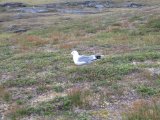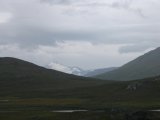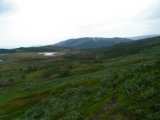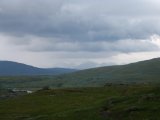Sunday 6/8

Viejejĺhkĺ – Bĺllávrjĺhkĺ
| Horizontal distance: | 17.5 km |
| Vertical distance: | -200 m, +40 m |
| Time: | 5 h 30 min |
| Lunch break: | 45 min |
| Dinner: | Wolffish casserole |
| Night accommodation: | Tent |
| Stage classification: | Easy/Medium |
There were some showers and moderately strong winds during the night, but when I got up at 07:30 only the wind remained, which was now coming from the exact opposite direction compared to the day before. A few drops fell from the sky, and I could see a small, thin rain cloud directly overhead against the overcast ceiling; it looked better to the south and west, but considerably worse to the north and northwest. I also saw some reindeer a short distance away.
I deemed conditions stable enough to prepare breakfast outside, and when I was just finishing up a very light drizzle started. It wasn't much to worry about, so I just stowed away my stuff inside the tent and remained outside to eat, together with a family of reindeer. As I was washing up afterwards the drizzle turned into actual rain, albeit still of the light kind, and the view towards the fjelds beyond Virihávrre, which had been almost clear in the morning, was now all white, so I did all my packing inside the tent.
I bided my time, playing a bit of solitaire and hoping for the rain to cease, at least long enough for me to strike the tent under reasonably favorable conditions. There was, however, no sign of change, so eventually I put on my rain clothes and dismantled the tent anyway. The rain remained light and it was fairly warm when I set out at 10:00, following the western bank of Viejejĺhkĺ.
After the canyon there were very nice grass plains right next to the stream, which I am sure would make excellent camp sites. There were reindeer all about, and soon I reached the second canyon, which is much smaller than the one I camped by. I passed a number of tributary streams without difficulty – even the larger one from Jĺllejávrre, which at first glance seemed as though it might give trouble, but I was able to just walk across with some care. There was a footpath following Viejejĺhkĺ, and I followed that where I could, but it was only clearly defined for short sections, and prone to disappearing almost entirely.
Further downstream, where Viejejĺhkĺ is wide enough to support a few islets, I stopped trying to make out the path and instead walked down at the shore, partly because I intended to ford the stream soon. I made an attempt about a kilometer later, but the water was just deep enough to reach above the shafts of my boots, so I aborted and continued a few hundred meters right by the edge of the water, until I found a place where I did get across.
Once on the other side I climbed the slope until I reached another faint path, which I had seen traces of earlier. Actually, there were several paths running at different elevations, so I just followed whichever was best at the moment. The ground was rather wet and stony, and as the path(s) proceeded into a region of osier thickets, progress became more difficult. By then two main paths could be detected – the one I was currently on, and one that ran closer to the stream, and since the vegetation seemed worse closer to the water I maintained my altitude. The thickets were very dense and high at times, and often I wasn't sure if I was actually on the path, but I managed to get through without too much twig-wrestling, and in one place I even noticed something I had not seen for days – a boot print.
As I was nearing the end of the bushes, a rather strong easterly wind picked up, but when the path – which was now clear – started descending towards the marked trail to the Staddajĺkkĺ cottages it abated somewhat. This descent was easy, and standing in the upper part of the slope I saw a pair of hikers at the bridge over Viejejĺhkĺ – the first living beings I had seen since leaving Pieskehaure, excepting reindeer and birds. I stayed on the path until it connected with the trail, and continued north for a bit. I met another two people, an elderly couple who had an interesting packing arrangement (she walked on ahead holding nothing but a staff, while he carried everything else on his back), and then I walked over to a large boulder next to a small brook to pause. Luck had it that this rock was so shaped that its upper parts jutted out on the lee side, creating an overhang which considering the wind gave full protection against the rain, so I sat down there at 12:15 to eat.
The rain had already lessened, though, and while I was sitting there it stopped entirely, so I exchanged the rain clothes for my wind dress before continuing. According to the map, a path would branch off the trail to the northeast just about where I was, cutting across the slope and reconnecting with the eastward Padjelanta Trail – taking this would remove the need to go down to the actual trail juncture at Biedjovárátja, but I never found it. Not that that mattered much, and instead I got a closer look at the well-known Sámi encampment Stáloluokta by the shore of Virihávrre.
After the juncture there was an appreciable wind, and I kept adjusting the jacket's zipper to maintain a comfortable internal climate. There was also a bit of drizzle now and then, but as the wind dress can handle some wetness I didn't bother to change. I met two hikers, one small rodent of some kind, and then another four humanoids at the stone ring depicted below, where I turned around to find the view over Virihávrre much clearer than before. A helicopter headed for Stáloluokta flew by, and then I encountered two foreigners who wanted to know how much farther they needed to go. The wind kept changing, and I grew more and more aware of an ache in my right hip, and to a lesser degree my feet. As I was passing through the grass-and-osier regions by Gieddávrre – even though the path was wide and well-trodden, some force was required here and there among the tougher shrubs – the helicopter returned to Kvikkjokk, and then I reached the bridge over Bĺllávrjĺhkĺ.
Despite the fact that the latter stages of the passage through Viejevágge were clearly more arduous than anything that followed, I found the portion on the Padjelanta Trail rather tiring; my aching hip probably had something to do with it. As a consequence, I started looking for a good camp site right there at the bridge – there was a fairly large level field on the eastern bank north of the trail which surely would have done nicely, but I instead chose to break off to the south, following the stream more closely while the trail continued atop a rise.
After a while of somewhat burdensome progress, I spotted a bare patch in the midst of all the osier a bit ahead, and upon reaching it it was clear that it had been used as a camp site many times before; there was a fireplace and some logs off to one side, and paths had been cleared through the thickets, both upwards in the direction of the trail and down to the stream. Finding this a perfect location, I started pitching my tent at 15:30 – a process which this time entailed some trouble with ascertaining the direction of the wind, and towards the end of it the rain returned in increasing quantities, so I dived straight in upon completion.
Once inside I just relaxed for a while and played some solitaire, while the wind ripped at the fabric and several more choppers passed by overhead. Since the rain also continued, I prepared dinner inside the tent. Later on, during a period of lesser rain and wind, I went out to do some adjustments to the guylines, the distribution and tension of which had not been optimal. I spent the rest of the evening in the tent, playing solitaire and solving crosswords. The weather forces kept changing back and forth in intensity, until drops finally stopped falling from the sky, leaving only the wind – and a fair number of insects.
I went up onto the rise to survey the situation, and found the surroundings brighter than before, the somewhat late hour notwithstanding. Visibility to the west was rather good, but the northeast was dark. The clouds to the south seemed higher, however, and even though there was a strong wind up where I stood it wasn't that cold. I returned to the tent to rest and then had my evening snack, by which time I could guess at some blue tones above. The clouds were drifting towards the northeast, leaving a light area in the southwest, so things were looking up.
As any experienced camper knows, a good, steady wind following a rainfall is a desirable thing, as it helps to dry one's tent, and mine bore only traces of moisture by then. The wind had abated somewhat, though, and it actually felt quite warm, in relative terms. I went to bed at 21:30 and read for a bit, noting that Gierggevárre was entirely free of clouds as I put the book down some time later.



























